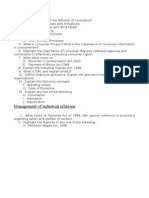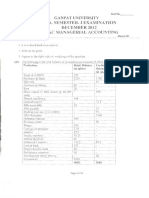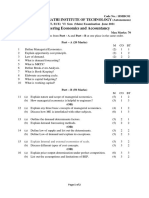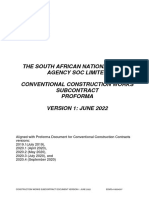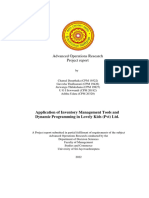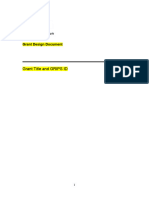H.T.No.
Code No: BA3504 SRGEC-R20
IV B.Tech I Semester Regular Examinations, December 2023
ENGINEERING ECONOMICS AND FINANCIAL ANALYSIS
(Civil Engineering)
Time: 3 Hours Max. Marks: 70
Note: Answer one question from each unit.
All questions carry equal marks.
5 × 14 = 70M
UNIT-I
1. a) Describe Giffen goods and why they violate the law of demand. (7M)
b) Explain how Veblen goods defy the law of demand. (7M)
(OR)
2. a) What is the need for forecasting demand? (6M)
b) Compare and contrast the different methods of demand forecasting, including survey,
statistical, and other methods. Analyze the advantages and limitations of each approach.
(8M)
UNIT-II
3. a) Explain the role of BEP in business decision making. (6M)
b) Consider the following data of a company:
Sales = Rs. 80,000;
Fixed cost = Rs. 15000;
Variable cost = Rs. 35000;
Find the following: (i) Contribution (ii) Profit (iii) BEP (iv) Margin of Safety. (8M)
(OR)
4. a) Explain the difference between fixed costs and variable costs. How do these costs behave
as production levels change? (7M)
b) What are opportunity costs, and how do they relate to decision-making in business?
Provide an illustrative example. (7M)
UNIT-III
5. Illustrate the following pricing methods
a) Cost based and Demand based Pricing. (8M)
b) Competitive based Pricing. (6M)
(OR)
6. Using a real-world example, discuss how a monopoly's pricing and output decisions are
influenced by its unique market position and the absence of direct competition. (14M)
Page 1 of 2
UNIT-IV
7. Kiran is a sole proprietor. Over the past decade, her business has grown from operating a
neighbourhood corner shop selling accessories such as artificial jewellery, bags, hair clips and
nail art to a retail chain with three branches in the city. Although she looks after the varied
functions in all the branches, she is wondering whether she should form a company to better
manage the business. She also has plans to open branches countrywide.
(i) Explain two benefits of remaining a sole proprietor
(ii) Explain two benefits of converting to a joint stock company
(iii)What role will her decision to go nationwide play in her choice of form of the
organisation? (14M)
(OR)
8. a) What is Partnership? What are its chief characteristics? Explain. (7M)
b) Describe the merits and demerits of Joint Stock Company? (7M)
UNIT-V
9. Mr. Normal has the following transactions in the month of April. Write Journal Entries for the
transactions. (14M)
10th April : Commenced business with a capital of Rs.1,00,000
11th April : Purchased goods from Veeru for Rs.20,000
13th April : Purchased Goods for Cash Rs. 15,000
14th April : Purchased Goods from Abhiram for cash Rs.9,000
16th April : Bought Goods from Shyam on credit Rs.12,000
17th April : Sold goods worth Rs.15,000 to Tarun
19th April : Sold goods for cash Rs.20,000
20th April : Sold goods to Utsav for cash Rs.6,000
21st April : Sold goods to Pranav on credit Rs.17,000
22nd April : Returned goods to Veeru Rs. 3,000
(OR)
10. The following are the closing balances extracted from the books of Bharath for the year
ending 31st December 2006 with the help of which prepare Trading Account, Profit & Loss
Account and Balance Sheet (14M)
Debit Balance Rs. Credit Balance Rs.
Opening Stock 6050 Sales 13720
Purchases 9030 Purchase Returns 130
Carriage 220 Capital 3000
Drawings 450 Creditors 4500
Investments 3800 Discounts Received 350
Debtors 2500 Mortgage Loan 4000
Cash 1350
Printing Charges 1200
Wages 1100
Total 25700 25700
Adjustments:
(i) Closing stock was valued at Rs.16, 000.
(ii) Wages outstanding by Rs.900. (iii) Write off bad debts Rs.500.
***** Page 2 of 2




























